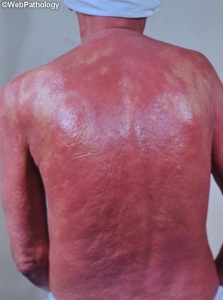Clinical Presentation of Sézary Syndrome
Sézary syndrome (SS) is a leukemic type of cutaneous T cell lymphoma (CTCL) in which the peripheral blood contains a large number of circulating malignant (Sézary) cells. SS is assumed to be made up of mature epidermotropic skin homing CD4+ T cells or central memory T cells. The goal of this discussion is to go over the clinical characteristics of SS.
Skin lesions — SS patients typically have extensive erythema that is finely scaled, indurated, or resembles livedo reticularis. The severity of erythema and the amount of body surface area (BSA) involved may fluctuate, but at some point during the disease’s course, the skin involvement must cover >80% of the BSA to meet the SS definition from The International Society for Cutaneous Lymphoma (ISCL), European Organization for Research and Treatment of Cancer (EORTC), and United States Cutaneous Lymphoma Consortium (USCLC).
The following is an overview of the skin lesions:
- Keratosis pilaris-like lesions –Follicular involvement may be characterized by inflamed follicular-based papules or scale.
- Alopecia – Alopecia is common and manifests as a loss of hair density all over the scalp and body, or as patches of alopecia.
- Ectropion – Because of the tautness and induration in the skin, an outward tilting of the lower eyelid with increased exposure of the ocular surface and sensitive mucous membranes of the inner lid might develop, which may be related with disruption of normal tear drainage pattern.
- Keratoderma – Keratoderma, or thicker keratin retention on the palms and soles, is a typical feature that can help distinguish SS from other causes of erythroderma, but it can also make the diagnosis between SS and pityriasis rubra pilaris difficult.
- Hypertrophic nails – Because of the involvement of the posterior nail fold, the nails may become hypertrophic.
- Erosions and superinfection –Patients are frequently colonized with Staphylococcus aureus, and persistent scratching causes erosions and superinfection.
- Focal areas of scaling – Tinea corporis is prevalent, and if scaly areas are present, a potassium hydroxide preparation should be conducted.
- Lichenification – Long-term disease, chronic pruritus, and scratching can cause diffuse lichenification, which is defined as thickening skin with enlarged skin lines. Fissures are a regular occurrence.
Lymphadenopathy — Peripheral lymphadenopathy is common, and a biopsy usually reveals either dermatopathic changes or lymphoma-like alterations, both of which are linked to the underlying cutaneous lymphoma.
Viscera — The prevalence of visceral involvement in SS patients is unknown. Because bone marrow examination is not frequently conducted, unless in the case of unexplained hematologic abnormalities, the prevalence of bone marrow involvement is unknown.
Pruritus — The most common and debilitating symptom of SS sufferers is pruritus. The length and depth of erythema, as well as the degree of blood involvement, are not always connected to the degree of pruritus. Pruritus can make sleep problems, anxiety, and depression worse.
Written by: Lama Altamimi, medical intern.
Reference: UptToDate
https://www.uptodate.com/contents/clinical-presentation-pathologic-features-and-diagnosis-of-sezary-syndrome?search=%20S%C3%A9zary%20syndrome&source=search_result&selectedTitle=1~58&usage_type=default&display_rank=1#H449464055

